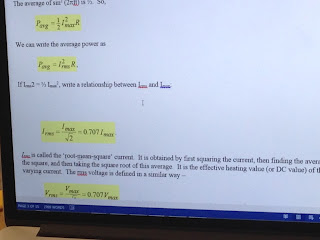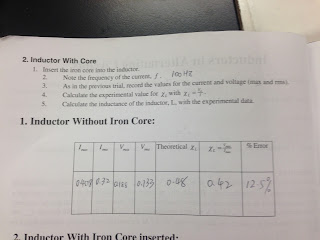In this experiment, we need to found out Vrms,Irms and Z. Then we need compare the Z we found and theoretical Z.
These are current graph and voltage graph we found by using Logger Pro.
Logger Pro can not collect current and voltage data at same time for 1000Hz,so we decided to collect separately.

This is our chart for 10Hz and 1000Hz frequency.
We used our experimental data to calculate the phrase change.
We used our theoretical data to calculate the phrase change and we see they are very close.
In this picture,we found out the frequency for the RLC circuit.
If frequency is 3000Hz, we calculated and found out Irms is 2.06A.
We found power in the circuit is 42.4W.
This is our set up for RLC circuit experiment.
Last, we calculate Zexp is 15.5.
Conclusion:
Today, we mainly studied on RLC circuit. At beginning of the class,we did a experiment and filled a chart for 10Hz and 1000Hz frequency. Then we calculate the phrase change by using experimental data and theoretical data. Last, we started to learn RLC circuit and did some calculation on RLC circuit.
































































